Is obesity in your genes? This week we find out how hormones, genetics and even your mother's diet contribute to your chances of becoming obese and succumbing to obesity-related diseases. We also take a look into the surgical way to lose weight fast - liposuction, figure out how the lengths of your fingers predicts your financial prowess and uncover a new source of antibiotics from the sea. Plus, is there life on Mars? We talk with the NASA scientist who recently discovered methane on the red planet to find out what this might mean, and in a fruity edition of Kitchen Science we explore the wobbly chemistry of jelly!
In this episode
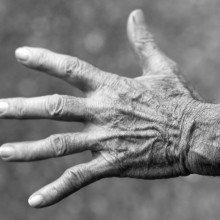
01:34 - Fingers and Traders
Fingers and Traders
The length of your fingers determines whether you've got the Midas touch...
Scientists have revealed this week that the relative lengths of a persons' fingers can predict money-making ability on the financial markets. Cambridge University Judge Business School researcher John Coates and his colleagues, who also made headlines last year by showing that testosterone levels amongst city traders were linked to their daily profits, took photocopies of the palm-prints of 44 financiers. The researchers measured the lengths of the index and ring fingers to find a strong association between the finger length and profit or loss.
Traders with an index finger shorter than the ring finger were more successful, on average, and the larger the ring finger relative to the index finger - known as the 2D:4D ratio - the more money they made.
"This is an index of testosterone exposure during development," points out Coates. "Some of the same genes that control limb and hand development in the embryo are also involved in the development of the urogenital system, so finger length is an index of pre-natal testosterone levels. Testosterone therefore seems to pattern the body and behaviour later in life; we see the same relationship amongst sportsmen playing testosterone-charged sports."
In the present study the researchers looked at a specific group of traders who aim to profit by gambling on second-by-second and minute-by-minute fluctuations in the values of certain assets.
"These high frequency trades require the same testosterone-fuelled rapid reactions that benefit an athlete on the sportsfield," says Coates, "although not all financial roles benefit from high testosterone. Some money-making schemes require traders to take a much longer-term view and high testosterone is unlikely to be of benefit under those circumstances." So the bottom line is, when making short-term bets on stocks and shares, measure your brokers' fingers; ideally before you threaten to break them!
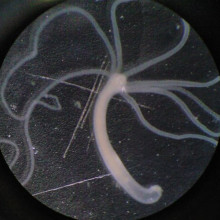
Miniature water creatures harbour antibacterial secrets
As you can read in any paper, there are big problems today with hospital-acquired infections - people picking up nasty bugs in hospital - along with antibiotic resistance, meaning we have fewer weapons in our fight against bacteria. So the search is on for new antibiotics.
 Now scientists at the university of Kiel in Germany have found an unexpected source of new bug-busters - tiny animals known as Hydra. These tiny creatures, just a few millimetres long, live in freshwater ponds and streams. Writing in the Journal of Biological Chemistry, Joachim Grötzinger and his colleagues have discovered a new protein in Hydra, which they've called hydramacin-1. And it has powerful anti-bacterial action.
Now scientists at the university of Kiel in Germany have found an unexpected source of new bug-busters - tiny animals known as Hydra. These tiny creatures, just a few millimetres long, live in freshwater ponds and streams. Writing in the Journal of Biological Chemistry, Joachim Grötzinger and his colleagues have discovered a new protein in Hydra, which they've called hydramacin-1. And it has powerful anti-bacterial action.
What makes hydramacin-1 unusual is that it isn't at all similar to most of the other anti-microbial proteins that scientists have previously discovered, and seems to be part of a new protein family. Looking at the 3-D structure of hydramacin-1, the team found that it is most closely related to a superfamily of proteins including some found in scorpion venom, and also two leech proteins. This is potentially powerful, as it means that it's a new angle to try in the war on bacteria.
Lab tests showed that hydramacin-1 could kill a wide range of different bacteria, including bugs called Klebsiella oxytoca, which are a common culprit in many hospital-acquired infections. The researchers found that hydramacin-1 works by sticking to the surface of bacteria, causing them to lump together, then breaking the bacterial cell membranes so they are killed.
Although this is a long way from being a commercial microbicide or treatment, it's yet another small step forward on the human front in our war on bugs.
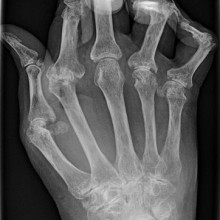
Rheumatoid Arthritis B-Cell Breakthrough
A new discovery has shed light on the mechanism by which joints are damaged by rheumatoid arthritis, scientists announced this week.
 Writing in this week's edition of the journal PLoS Medicine Barts and the London Medical school researcher Constantino Pitzalis and his colleagues collected samples from the inflamed joints of patients affected by the disease, which affects about 1% of the adult population and occurs when the immune system mistakes healthy joints for hostile tissue and attacks them.
Writing in this week's edition of the journal PLoS Medicine Barts and the London Medical school researcher Constantino Pitzalis and his colleagues collected samples from the inflamed joints of patients affected by the disease, which affects about 1% of the adult population and occurs when the immune system mistakes healthy joints for hostile tissue and attacks them.
"What we have found is that a class of infection-fighting white blood cells, called B lymphocytes, make their way to affected joints where they set up structures called germinal centres. These function as antibody factories, producing antibodies that then attack the joint tissue," says Pitzalis.
To prove that this was the case the team injected immune cells from rheumatoid patients' joints into the skins of mice genetically programmed to lack an immune system of their own. For 90 days the team were able to detect the antibodies in the blood of these so-called SCID (Severe Combined Immuno-Deficiency) mice.
"This shows that the germinal centres are sufficient to produce the antibodies directly in the joint," Pitzalis explains.
Apart from providing new insights into the mechanisms of rheumatoid arthritis, which costs the NHS more than £1.2 billion per year to treat affected patients, the new research may also help with the development of better drugs and better use of the drugs we do have to control the disease.
"To stop the damage done by rheumatoid arthritis we need to selectively kill the B-cells making the rogue antibodies," says Pitzalis. "This animal model can help us to do develop cost-saving ways to do that."

Talking about post-natal depression
Post-natal depression affects a significant proportion of new mothers. Some studies suggest one in twenty may be affected, while others show it could be as high as one in four. Not only can this be a problem for the mother, but it can also have an impact on her child and its care, and in the worst cases can lead to women taking their own lives. New mums with post-natal depression may be offered anti-depressants, but many don't want to take them, especially if they're breastfeeding.
 Now researchers from the University of Toronto have discovered that talking things through with someone who understands what you're going through can cut the chances of post-natal depression by around half.
Now researchers from the University of Toronto have discovered that talking things through with someone who understands what you're going through can cut the chances of post-natal depression by around half.
Writing in the British Medical Journal, Dr Cindy-Lee Dennis and her team used a web-based tool to screen more than 21,000 new mothers in the Canadian province of Ontario, to find those who seemed to be at risk of developing post-natal depression. Then they recruited around 700 women, and divided them randomly into two groups. One group got standard post-natal care, while the other group got the same care, but also had telephone support from a volunteer who had also gone through post-natal depression.
The researchers found that the mums who got support over the phone had half the risk of developing depression three months after their birth than the women who just got standard care. And eight out of ten of them said they were happy with it, and would recommend it to a friend. Dr Dennis says that women and their families need to know more about post-natal depression, and that putting new mums at risk in touch with women who've been through it could be a significant way to help. But this needs doctors, nurses, midwives and other health professionals to be aware of the risks an symptoms, so they can offer the right support at the right time.

11:01 - Does methane on Mars mean life?
Does methane on Mars mean life?
with Dr Mike Mumma, NASA Goddard Centre for Astrobiology
Chris - Tell me about this methane, how did you find it in the first place?
Mike - Well, we were searching for it since 1999, actually. We are using a spectroscopic technique from the summit of Mauna Kea which is a very high volcano in Hawaii, 14,000 feet, where unlike most of Hawaii it actually snows once in a while. In any case we started then and by 2003 we had actually detected the gas using a technique called infrared spectroscopy and looking for vibrational bands of methane and of water at the same time.
Chris - Why did you go looking for it in the first place?
 Mike - Of course, one would not expect to find methane on Mars because it's an oxidising atmosphere. Unless it were released very recently, otherwise the lifetime of methane would be too short to have a significant abundance in the atmosphere. The general view if methane is released it could only be coming from one or two potential sources: one being geochemistry of one or two kinds and the other being biology of one or two natures.
Mike - Of course, one would not expect to find methane on Mars because it's an oxidising atmosphere. Unless it were released very recently, otherwise the lifetime of methane would be too short to have a significant abundance in the atmosphere. The general view if methane is released it could only be coming from one or two potential sources: one being geochemistry of one or two kinds and the other being biology of one or two natures.
Chris - So you think that in the same way that the early Earth was populated by methanogens, bacteria that make methane and actually were quite beneficial to us because they warmed up the Earth and made it the propitious environment for other kinds of life like us to exist later, you think the same thing might be happening on Mars?
Mike - It very well could be. In fact, we can take a message from the deep biosphere below South Africa where scientists have discovered that there are bacteria down there which actually metabolise in total absence of sunlight. They use radiolysis to break water into molecular hydrogen and oxygen and then the bacteria basically eat that hydrogen and use a gas called hydrogen sulphide as a result. It's not a great stretch to imagine that a methanogen might exist in the environment in Mars and using energy from radiolysis at least and then excreting methane which is then released into the atmosphere.
Chris - So having identified the fact that you've got this methane signal in the atmosphere around Mars how did you then further develop the investigation to try and work out where it was coming from?
Mike - We used a spectrometer that has a long entrance slit and we placed that slit along the north-south meridian of the planet, the midline dividing east and west hemispheres. Then we take 50 spectra at 50 locations along the slit and a cadence of every 60 seconds. So every sixty seconds we get a new set of spectra. Depending on how we combine those spectra we can choose the range of longitudes that will pass under the slit during the interval. For example, in the case of a 5 or 6 hour interval Mars will rotate approximately 60-80 degrees of longitude in that time. This way we can then later convert the measured spectra taking latitude from the top and bottom of the slit and longitude with time and develop a map of methane.
Chris - So the planet effectively, because it's rotating, surveys itself which is very convenient. What did this tell you? What did you see?
Mike - The big surprise was not just that we had detected methane but actually we see three regions of active release which are fairly closely grouped, to within 500,000km of one another. One region is over the district called Nili Fossae. This is a canyon system which is known to be a site where phytosilicates - clay minerals that form in liquid water - and also carbonates are found by Mars Express and also by an instrument on the Mars observer craft. What's interesting is that this is also a region of intense release of methane. Of course methane could be associated with water early in Mars' history or even now below the surface.
Chris - Is the release that you're seeing constant? Are you continuously seeing methane pumping out or does it come in spurts?
Mike - In fact it does not come out continuously. We find that between midsummer in the north when we see the maximum release and the next equinox season the methane is largely destroyed by a factor of 2 on Mars by a process we think is related to airborne dust. This methane is being released now in midsummer in the north. That's what we reported this week. Indeed, we think this is a very important window into an active Mars which we had not had before.
Chris - So the obvious question is now you've got two choices. It's either life or it's not life, it's something geological. You've gotta answer that question, how are you going to do it?
Mike - Well, we've started the test of these two hypotheses. One is to look for geological gases which would accompany either a geochemical production or biological production. So we've started a deep search for those gases in 2006. Unfortunately that's the season of equinox when we don't see the methane ever. They weren't so meaningful then so we'll be beginning again this fall, August 2009, at the very large telescope.
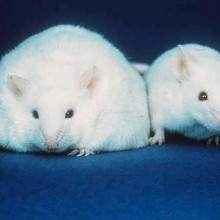
20:44 - Hormones of Obesity
Hormones of Obesity
with Steve Bloom, Imperial College London
Chris - And someone who is an expert on obesity is Professor Steve Bloom. Welcome to the Naked Scientists. Let's put some numbers on it first of all. How big a problem is obesity?
Steve - About 80 excess deaths a day in the UK at the moment. That's an awful lot of people who are dying prematurely. It's a really serious condition.
Chris - Linked to - what sorts of conditions are these people dying of?
 Steve - Well, mostly heart disease, stroke, diabetes but really the interesting thing that we found only recently is it virtually doubles your cancer rate. So it's rather more serious for cancer than cigarette smoking.
Steve - Well, mostly heart disease, stroke, diabetes but really the interesting thing that we found only recently is it virtually doubles your cancer rate. So it's rather more serious for cancer than cigarette smoking.
Chris - Do you have any clue as to why it might do that?
Steve - Well, for certain sorts of cancer, for example cancer or the uterus or breast, hormones get converted in fat tissue into something that's more deleterious for you. Actually several other types of cancer are affected which don't have any real reason. So we assume there's some sort of growth factor but actually don't know the details. All we do know is that if you do something about the obesity the cancer rates drop back again. It looks as if it really is the cause.
Chris - Some people have suggested that because our body strives to maintain a constant body weight but if you take too many calories in it has to burn of some of the calorie excess. In the process of burning off some of the excess it could produce harmful chemicals, things like free radicals, which will damage your DNA and that could provoke cancer.
Steve - People have been attempting to find something about free radicals for a very long time. So far it remains very theoretical. In fact, metabolic rate isn't very much affected by obesity. It turns out that in the UK we've been eating, if anything, slightly less but we've been taking a lot less exercise over the last 20 years. The reason for us getting fatter is that we have a mismatch between the amount we eat and the amount of exercise we take. We're actually eating slightly less.
Chris - So why are we seeing these record levels of obesity? What's going on?
Steve - Basically, you don't walk up the stair any more. You take the elevator. I was reading an old history book and someone living in London wanted to go to Brighton so he walked. Would anyone walk to Brighton today?
Chris - Would anyone go to Brighton today? Just joking. Let's look at how appetite gets determined and controlled in the body. What do we now understand about what makes me want to put food into me and then stop eating when I'm full?
Steve - It's completely normal to want to over eat. We're a species that survived endless famines and the people that lived through the famine were the people that put on extra weight when there was food around. You can think of it during the summer when there's a harvest or lots of game to catch; if you don't put on more weight you won't live through the lean winter. We're designed to get fat and the trouble is that the supermarkets are providing us with delicious food, high calorie food all the time, all through the year, yea- in and year-out. So we have relatively speaking too much food. As I say, we don't take enough exercise.
Chris - As you say, our genes are dictating that we store this energy but how are our genes telling us to behave the way that we do, to over eat?
Steve - That's just the way we're designed. If you didn't over eat when food was plentiful you died out in the next famine. We are the survivors of endless famine. We're the people that stole the last crust of bread. Actually, rather interestingly if you use up too much energy you also don't live. You could describe the human race as greedy and lazy.
Chris - That's a pleasant thought, isn't it? One thing to point out, what about the fact that hormones must have a role to play in this? I feel full when I eat something. I can also detect changes in the levels of the blood of various chemicals. Tell us something about those.
Steve - If we think of something like a vole or mouse or rat, if they don't get into their hole in a hurry they get eaten. We know that predation of small mammals - and we are evolved from small mammals that lived through the dinosaur era - predation increases as they get fat and they can't get away so fats. It's really important not to allow obesity to get out of control. So we do, indeed, have hormones which regulate our appetite. Our own research has been on the very simple question, why do you feel less hungry after eating lunch?
Chris - What are you finding?
Steve - Well, we're finding that the gut releases a lot of satiety-inducing hormones. So when you take food in the hormones are released from the gut, go round the circulation act on a central part of the brain called the hypothalamus where all the drives are located and decrease your desire to eat. This gives quite an interesting therapeutic possibility as you might imagine.
Chris - But of course some people do eat too much and they weren't always fat. Why is it some people gain weight and other people seem to be able to eat whatever they like and they don't?
Steve - If one assumes that our appetite level is set too high for modern society, what you might call the obesogenic environment with delicious food and no need for exercise then we're all following our natural genetic propensity to put on weight in this sort of environment. It's obvious that some people put on more weight than others. In fact, a tendency to put on more weight runs very markedly in families. If your parents were overweight, you tend to be overweight. If your parents were thin, you tend to be thin. This is true even if you're an orphan and brought up in another household. If your parents are thin but you're brought up in a fat person household you still stay thin. Genes are very important. They're the add-on to the obesogenic environment. What they do is they allow you to deal with an obesogenic environment or otherwise. One of the most interesting things about the human race is our tremendous variability. It was clearly an advantage that some people were good at firing arrows and other people were good at cooking and looking after the children. It seems that some of us are good at surviving famines and others of us are thin and lithe and able to fight off the enemy. A successful tribe has representatives of both.
Chris - It's a bit like ant colonies where one of the ants acts as a living larder where all the other ants feed it and it becomes stuffed with sugar. During the hard times it disgorges some of this sugar and keeps the other ants alive again. Let's focus on the hormones that are doing this because that's probably the area of most interest. What mediators of appetite do we know about now?
Steve - If I just step back and say we have no very good treatments for obesity, no medicines you can take that'll destroy your appetite. There is one procedure that really works and gets fat people to be thin for the next twenty years and that's bypass surgery which bypasses the upper gut. Basically, what that does is it fools the gut into thinking something's wrong. It's eaten a lot of food when actually hasn't and it then releases a lot of these hormones. We can measure them and show that they're very high. This successful surgical procedure works by chronically increasing the release of the satiety hormones from the gut. The trouble with the surgery is it's got a 1/30 death rate and it's really quite expensive and pretty arduous. On the whole I'd rather not go in for the surgery if I had an option. The objective of our research is to isolate these hormones, purify them, make them long-acting and then make them available as some sort of therapeutic administration to chronically restrain people's appetites as if they had something wrong with their gut so they don't feel hungry all the time.
Chris - And have you got any molecules that show promise in this direction yet?
Steve - yes, we've got several. We successfully set up a spin-out company which developed one and began to administer it in humans and has now been adopted by a large pharmaceutical company as one of their leading products in the field of obesity. That's likely to go on. Meanwhile my laboratory is working on several more. There's not just one hormone, there's about four of them. The body normally works by releasing several. This is probably an important safety feature so that if you get a parasite in your gut it can't fool your gut into losing its appetite spuriously because you need to have more that one hormone for the effect. This makes it a little difficult to develop a successful therapy but we think we've done it now, actually.
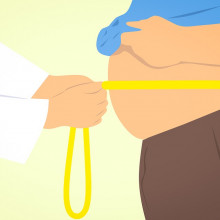
30:00 - Surgical Fat Loss - Liposuction
Surgical Fat Loss - Liposuction
with Brian Mayhew, Cadogan Clinic
Meera - In this day and age, with cosmetic surgery becoming quite a common occurrence some people resort to liposuction to remove this weight. This week I'm at the Cadogan Clinic, a day surgery centre in London. With me is Dr Brian Mayhew, the man who first introduced liposuction to the UK. Brian, what exactly is liposuction?
Brian - Liposuction is simply removing fat by the most convenient way. You can just remove fat by cutting it out but then you're left with scars and a rather uneven shape. With liposuction you can take the fat out quite smoothly. It's basically loosened by rasping it with the end of this tube or canula that we use and sucking it out into a bottle. Once it's sucked out it doesn't come back.
Meera - Why does sucking out the fat make a bigger difference than say if someone lost weight and reduced their fat cells?
Brian - Normally when people put on weight their fat cells just get bigger. When they lose weight they get smaller but there's no reduction in number of cells. Here we're reducing the number of cells and therefore the shape.
Meera - We're actually down in one of your operating theatres at the moment. I can see the liposuction machine in front of me. It's kind of a tall, rectangular unit which has bags of solution hanging from the top of it. How does this machine work to actually suck fat out of people?
Brian - The basic principle is we've got a suction machine and we suck out the fat as fast as we can. The maximum we can achieve is one vacuum so we try and get as close to that. We have some fluid in some bags to which we add adrenaline to reduce bleeding. It restricts the blood vessels. There's bicarbonate as well. This is just used for the pH to the body pH. If it's not the same pH it's uncomfortable and local anaesthetic short-acting and long-acting. Very often the patients are asleep during this, it's under general anaesthesia. It's perfectly possible to do it under local. In this particular machine which is use, the body jet machine, the water-assisted machine there's a small tube coming up the cannula that squirts out, like a pressure washer, the local anaesthetic. If we just do it slowly people don't feel any pain. Fat doesn't have a lot of nerve endings in it and then we suck out the fat in an even manner.
Meera - Does the solution break up the fat cells and just make it easier to suck up the fat afterwards?
Brian - Generally the removal of the fat is done by the rasping action of the blunt end of the cannula. It's the mechanical action of the fat against the blunt edges of the cannula. Fat is sort of sucked through these holes and as you move the cannula back and forth it sort of pulls, drags it away from its bearings. Dragging it away is better than cutting. If you cut the vessels bleed. If you drag them they tend to contract. However, in this water-assisted technique this slight pressure of fluid does dislodge the fat. That's really quite useful where the fat's difficult to remove.
Meera - Is it purely fat cells you are sucking out or is there any risk of sucking out any other things in the process?
Brian - Most of the layers we're treating there is only fat there beneath the skin and the next layer down is the muscle which is pretty resistant to trauma.
Meera - I'd like to know a bit about what happens to the person afterwards. What are the risks of infection and things through this procedure?
Brian - Infection really doesn't occur with liposuction unless someone's doing something else as well: excision, some skin operation as well. Bleeding with the adrenaline it's reduced but it is only bruising. It does disappear so after about 3 weeks the visible bruising is gone and, depending on the area of the body, the healing process continues and deeper damage heals too; usually after about 3 months.
Meera - What about the functioning of the patient's metabolism? You've just removed all these fat cells from the person. What would happen if they were to put on weight?
Brian - They'd put on weight elsewhere in exactly the same way as they did before the operation. It doesn't affect that at all. They don't put it on at a greater or lesser rate but they don't have the fat being put on in the area that's treated. It's a permanent change of shape.
Meera - Even is someone does have liposuction they should really be having a healthy diet and reasonably moderate exercise afterwards in order to keep themselves that way?
Brian - Yes, that's absolutely right.
Meera - By the sounds of it this procedure is quite purely aesthetic. It's not an actual treatment for obesity as such.
Brian - no, it isn't really and if you were going to remove that amount of fat it would be many very big procedures and it would probably be very difficult to get the result even. The other limitation is just the general effect on the body. If we're removing more than about 3 or 4 litres of fat there's going to be a lot of bleeding. Therefore the haemoglobin will drop and people will feel very weak afterwards.
Meera - Could liposuction help to reduce the effects or chances of getting obesity-related diseases such as diabetes?
Brian - I have had a request of physicians who treated fat people who are diabetic to try and gain control of the diabetes. We haven't done enough to know if this is very effective or not but we certainly - that was the principle that we were working to and I think for some of those patients it did help them.

37:08 - Born Obese? Does your mother's diet affect your future?
Born Obese? Does your mother's diet affect your future?
with Professor Lucilla Poston, Kings College London
Kat - If a woman is overweight and pregnant, does it mean your child is likely to be overweight? We're joined by Professor Lucilla Poston from Kings College, London. She's researching how foetal nutrition affects people when they're grown up. Let's start with this thing about when you're pregnant you're eating for two. How does a woman's diet actually affect what's going on in her developing baby?
 Lucilla - Perhaps I should begin by saying it's never a good thing to eat for two. That's what a lot of women believe - that you need to eat more. You only need to eat a very little bit more when you're pregnant. We are beginning to see a huge explosion in understanding of how diet in pregnancy can affect the developing child and even increase the risk of some diseases as that child grows up. Most of the work so far has been in relation to undernutrition. People have shown that babies who are born small are more likely to develop diabetes and become obese when they grow up. We're particularly interested, in our work in London, in the effect of over eating in pregnancy and also if a woman is already obese when she becomes pregnant. It's been known for a long time that being obese during pregnancy is associated with lots of problems for the mum. She may have more diabetes, more pre-eclampsia and more cases of still birth. That indeed is a huge problem in the United Kingdom at the moment. We do know now that the children of women who are obese tend to be obese themselves. Well, you can say that's okay - they live in the same family and have the same genes and so on but there are some studies which suggest that there is something going on in relation to what the mother's eating or whether she's fat and in relationship with the child's obesity. There are some very good studies that suggest it's an independent association related to genes. Not convincingly proven yet but actually what is so interesting is that we've been looking at obesity in animals and we've been making mice and rats obese in pregnancy. We found remarkably that the young animals grow up obese even though they're eating a normal diet. That's got us really excited.
Lucilla - Perhaps I should begin by saying it's never a good thing to eat for two. That's what a lot of women believe - that you need to eat more. You only need to eat a very little bit more when you're pregnant. We are beginning to see a huge explosion in understanding of how diet in pregnancy can affect the developing child and even increase the risk of some diseases as that child grows up. Most of the work so far has been in relation to undernutrition. People have shown that babies who are born small are more likely to develop diabetes and become obese when they grow up. We're particularly interested, in our work in London, in the effect of over eating in pregnancy and also if a woman is already obese when she becomes pregnant. It's been known for a long time that being obese during pregnancy is associated with lots of problems for the mum. She may have more diabetes, more pre-eclampsia and more cases of still birth. That indeed is a huge problem in the United Kingdom at the moment. We do know now that the children of women who are obese tend to be obese themselves. Well, you can say that's okay - they live in the same family and have the same genes and so on but there are some studies which suggest that there is something going on in relation to what the mother's eating or whether she's fat and in relationship with the child's obesity. There are some very good studies that suggest it's an independent association related to genes. Not convincingly proven yet but actually what is so interesting is that we've been looking at obesity in animals and we've been making mice and rats obese in pregnancy. We found remarkably that the young animals grow up obese even though they're eating a normal diet. That's got us really excited.
Kat - There's a fundamental change in their metabolism?
Lucilla - Yes and what we're seeing is they're actually eating more so they have an increase in appetite and they sit around more. They're less active so as Professor Bloom was saying earlier it's all a relationship between what you've taken in and how much exercise you do. These animals seem to be eating more and taking less exercise. It's hardly surprising that they become fatter.
Kat - In my previous incarnation as a scientist I was working in the field of epigenetics, looking at how things that happened to your genes when you're developing as a foetus can affect the size that you are. Also, the thing we used to get told about in the field was the Dutch mothers, the women who were pregnant during the war. They had very little food and they had babies who were very small. Then when the war was over and everyone had enough food again these small babies who'd grown into women then had small babies themselves. It's suggested there's a change that actually happened to their genes. Is this the same thing going on but in fat?
Lucilla - Well there is certainly evidence that if you treat animals with less dietary intake, you give them an under-nutrition diet in pregnancy, you can show categorically that some of their genes are permanently changed. What people have been looking at is the methylation status of the promoter region of certain genes which control growth. They are remarkably different in the offspring of animals which have been subjected to under nutrition. On the converse side we're looking at that now in relation to obesity. There's much less evidence so far but we're beginning to see data coming out both from our laboratory and others that there are permanent changes to the expression of some genes. That could be due to altered methylation status. It's very exciting.
Kat - These are the switches that switch genes on?
Lucilla - Yep.
Kat - Those sort of mechanisms, they probably act - isn't it quite early in the development? What sort of time from the development form an egg to a foetus to a born baby are these kinds of influences of maternal weight acting?
Lucilla - We've been doing some work on preimplantation embryos. That's before the embryo gets embedded in the womb. We've been looking at mitochondrial activity and they're very different if the mother is obese. This is again from animal studies. It could suggest that very early on there's an impact of obesity. More recently we've been looking at the post-natal period and during the suckling period and we think that's incredibly important in relation to the development of the hypothalamus of the offspring. Professor Bloom was talking about that. The hypothalamus is the seat of energy control and it produces lots of peptides that control appetite. We're seeing remarkable changes in the expression of those peptides in the hypothalamus in the offspring of animals who are obese. It may be that the suckling period is particularly important or late gestation. Probably different periods all adding up to creating slightly different phenotype in the offspring.
Kat - And to stress this isn't just to do with the nurture, the type of household you're brought up where there's lots of food and if you're overweight it really is something that's in the genes and how they interact with the environment?
Lucilla - It's extremely difficult in human studies to tease out the contribution of genes and the contribution of the shared environment. People are trying to do that by statistical analysis and it is very hard to prove that this is an acquired defect in terms of appetite and obesity, so that's where the animal studies come in very strongly because obviously we could use animals of exactly the same genetic background, we can control the environment and so on. The animal studies at the moment are telling us far more than the human studies. Some human studies are planned, including in the United Kingdom whereby we're going to intervene in obese ladies' pregnancies to try and improve diet and then we'll be looking at the genes of their children to see if the intervention has had any effect in relation to the expression of some genes relating to appetite control and so on. We have the potential to do it. Most of the evidence so far has been from animal studies.
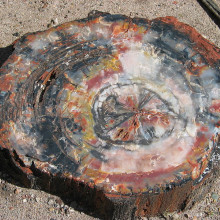
44:38 - How is petrified wood formed?
How is petrified wood formed?
We put this to Steve Laurie, Sedgwick Museum, University of Cambridge
Petrified wood is literally where the wood has been replaced by minerals. Sometimes it has a vague sort of woody texture, it looks a bit fibrous or it's got a ring structure. The best examples will have whole cell structures preserved, the cell walls and the cell interior's filled with mineral. You need to have water of the right chemical composition moving through the wood. It tends to be silica is the best chemical for replacing the wood. It actually reacts with cellulose and leaves a cells structure and gets bound in. Over millions of years it gradually changes from this strange mixture of cellulose and silica into opal and into a more crystallised form of silica. If you just randomly bang fence posts into British soil then probably it would take thousands of years to petrify a piece of wood in anything like normal conditions. If you have a fence post and throw it into, for instance, some of the hot springs in Yellowstone National Park then, yes you might get a decent piece of petrified wood out the end of it. That's very unusual.
Do the growth hormones given to animals have an effect on human obesity?
We put this to Professor Steve Bloom:
Growth hormone makes your muscles grow and burns up fat. In fact it will reduce your pot belly so it's quite useful in that way. There is a slight disadvantage which is also causes tumours to grow, being growth hormone. Your chances of getting cancer, particularly cancer of the prostate are somewhat increased. I'm afraid I can't really recommend it.
Is midriff fat worse than other fat?
We put this to Professor Lucilla Poston:
It certainly is. One of the best evidence that central fat is the worst sort of fat is telling us that's bad news. The reason is there are probably different fat depots in the body and they produce different chemicals. The ones produced by the fat around the midriff are probably the most damaging in relation to cardiovascular risk.










Comments
Add a comment